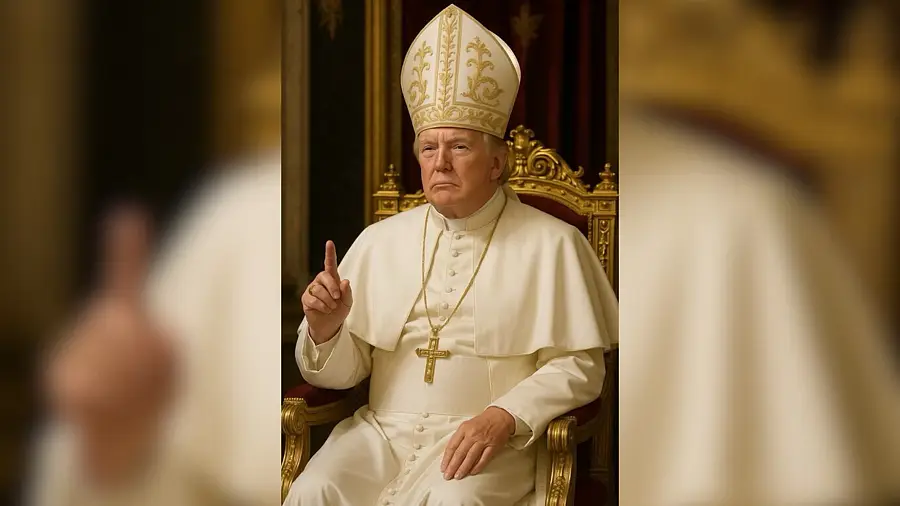[Latest News] Trump AI Pope Image Controversy: Backlash, Ethics & Misinformation
![[Latest News] Trump AI Pope Image Controversy: Backlash, Ethics & Misinformation](https://media.cnn.com/api/v1/images/stellar/prod/16x9-ai-generated-image-trump-pontiff.jpg?c=16x9&q=h_653,w_1160,c_fill/f_webp)
In the age of artificial intelligence, a single image can ignite a global conversation. That’s exactly what happened when former U.S. President Donald Trump posted an AI-generated image of himself dressed as the Pope. Shared across his Truth Social profile and echoed by his supporters, the image quickly went viral—but not without consequences.
This article breaks down the controversy, from the religious backlash to the ethical questions raised by AI-generated political media. Here’s what you need to know.
What Was the Trump AI-Generated Pope Image?
In late April 2025, shortly after the death of Pope Francis, Donald Trump posted an image on social media showing himself in full papal regalia. The image, created using an AI image generator, was shared during the nine-day mourning period leading up to the Papal Conclave—a sensitive and solemn time for Catholics worldwide.

While the post was likely intended to be humorous or provocative, the context in which it appeared—during religious mourning—added fuel to an already polarized digital landscape. AI-generated visuals have gone viral before, but few have struck such a deeply religious and political nerve.
Public and Religious Backlash to the AI Pope Image
The image was met with intense criticism, particularly from Catholic organizations and international religious leaders. The New York State Catholic Conference released a strongly worded statement:
“There is nothing clever or funny about this image, Mr. President. It is a mockery of our faith, our traditions, and the sacred office of the papacy.”
Criticism also came from Italian political circles. Former Premier Matteo Renzi described the image as “a deliberate provocation during a time of holy mourning.” Several Italian newspapers referred to the post as “blasphemous” and “deeply disrespectful.”
The backlash wasn’t limited to religious communities. Even some political commentators and digital ethics experts flagged the image as a misuse of AI in public discourse—highlighting its potential to mislead and desensitize viewers.
Trump’s Response and Defense of the AI Image
Unfazed by the outcry, Trump doubled down. He responded to the backlash with his trademark sarcasm:
“If I were Pope, the Vatican would have the best rallies. Period.”
His supporters, including Senator Lindsey Graham and political influencer Jack Posobiec, dismissed the controversy as “woke outrage.” They argued the image was satirical, meant to troll the media and critics.
However, many observers felt that humor didn’t justify the timing and symbolism. AI art may be harmless in a vacuum, but context matters—especially when you’re a former head of state with tens of millions of followers.
AI Image Ethics: Deepfakes and Religious Mockery
The incident highlights a broader issue in the modern media ecosystem: the ethics of AI-generated images and their use in public discourse.
AI-generated deepfakes—especially of public figures—can create confusion, mislead audiences, or be used to manipulate opinion. When religious symbolism is involved, the potential for offense skyrockets.
A 2023 study from RTE Brainstorm examined how quickly fake AI images go viral compared to real news. The results were striking: deepfakes were shared 3x more frequently than fact-checked content.
Religious mockery, even when unintentional, can lead to real-world consequences. In a hyper-connected world, AI misuse isn’t just a tech issue—it’s a cultural and ethical flashpoint.
Political Implications of the AI Image Controversy
Trump’s timing raised additional concerns. Sharing the AI Pope image during the Papal Conclave preparation led to accusations that he was attempting to influence religious opinion or stir unrest.
This isn’t the first time Trump has clashed with the Vatican. In 2016, Pope Francis criticized Trump’s border wall policy, suggesting it was “not Christian.” Trump fired back, accusing the Pope of being “politically naïve.”
The current controversy further strains that already tense relationship. Some critics also pointed to Trump’s nomination of Brian Burch, a conservative Catholic figure, as ambassador to the Holy See—a move seen by many as an attempt to steer Vatican sentiment.
AI and Misinformation in Modern Politics
The Trump AI Pope Image scandal also raises important questions about AI misinformation in politics.
AI-generated content is increasingly used for memes, political attacks, and propaganda. These tools can alter perception and twist reality, especially when images appear “real” at first glance.
According to Logically Facts, detecting AI images is becoming harder as generative models improve. Human eyes alone are often not enough to spot fakes.
Worse yet, when trusted public figures share such content, it legitimizes the technology’s unchecked use—even when it’s factually misleading or contextually offensive.
Expert Opinions on AI-Generated Political Media
Many digital ethics experts have weighed in on the issue. Dr. Sarah O’Connell, a media literacy researcher at Oxford University, explained:
“We’re entering an era where AI-generated media needs to be treated with the same caution as political ads. Labels, transparency, and context are everything.”
Others advocate for stricter AI regulations. Several EU nations are pushing for mandatory watermarking of AI-generated content, especially for political use cases.
There’s also growing demand for public education. Many experts believe that media literacy should be taught in schools to prepare the next generation for the reality of deepfakes and misinformation.
Conclusion: A Turning Point for AI and Public Discourse
The Trump AI Pope Image is more than just a meme—it’s a case study in the power and peril of AI in politics. It challenges us to think critically about how we use emerging technology, especially when it intersects with faith, culture, and public trust.
It also reinforces a need for ethical standards, regulatory frameworks, and most importantly—media literacy among users. As artificial intelligence continues to shape the information landscape, the responsibility lies not just with the creators, but with the consumers.
Whether Trump’s image was satire or strategy, it leaves us with one unavoidable truth: AI isn’t coming—it’s already here. And we must learn to use it wisely.
FAQ
❓ What is the Trump AI-generated Pope image?
It’s an AI-created photo depicting Donald Trump dressed as the Pope. It went viral after he shared it during the mourning period for Pope Francis.
❓ Why did Trump post the Pope image?
Trump claimed it was satirical, possibly to provoke media reaction. However, many see it as disrespectful and poorly timed.
❓ Is the AI image of Trump as Pope real or fake?
It’s fake. The image was generated using artificial intelligence tools like Midjourney or similar platforms.
❓ What are the dangers of AI-generated political images?
They can mislead audiences, erode public trust, and even stir social or religious tensions, especially when shared by influential figures.
If you found this article insightful, consider sharing it or linking to it in your blog or newsletter. For more AI ethics updates and digital media insights, follow us on Twitter or subscribe to our weekly newsletter.
